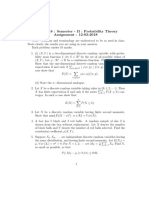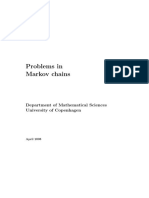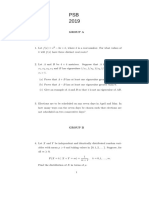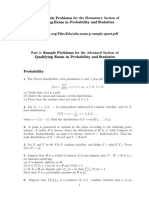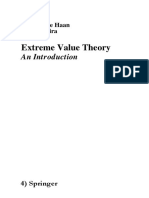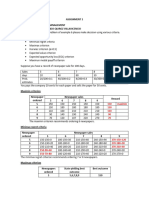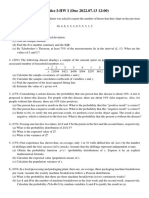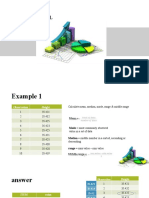AI5030 Homework 08
AI5030 Homework 08
Uploaded by
Aditya ShindeCopyright:
Available Formats
AI5030 Homework 08
AI5030 Homework 08
Uploaded by
Aditya ShindeOriginal Title
Copyright
Available Formats
Share this document
Did you find this document useful?
Is this content inappropriate?
Copyright:
Available Formats
AI5030 Homework 08
AI5030 Homework 08
Uploaded by
Aditya ShindeCopyright:
Available Formats
AI 5030: PROBABILITY AND STOCHASTIC PROCESSES
INSTRUCTOR: DR. KARTHIK P. N.
HOMEWORK 8
TOPICS: EXPECTATIONS OF DISCRETE AND CONTINUOUS RANDOM भारतीय ूौ ो गक संस्थान हैदराबाद
Indian Institute of Technology Hyderabad
VARIABLES, VARIANCE, COVARIANCE
Fix a probability space (Ω, F , P). All random variables appearing below are assumed to be defined with respect to F .
1. For any x ∈ R, let ⌊x⌋ denote the largest integer lesser than or equal to x. Thus, for instance, ⌊3.5⌋ = 3, ⌊−8.9⌋ = −9,
⌊2⌋ = 2, and so on.
Suppose that X ∼ Exponential(1). Determine the expected value of Y = ⌊X⌋.
2. Let X be a non‑negative and continuous random variable with PDF fX and CDF FX . Show that
∫ ∞ ∫ ∞
E[X] = P({X > x}) dx = (1 − FX (x)) dx,
0 0
where the above integrals are usual Riemann integrals.
Hint: Write down the formula for expectation in terms of the PDF, and apply change of order of integration.
3. Suppose that X and Y are jointly discrete random variables. The random variable X takes values in {−1, 0, 1} with
uniform probabilities. Suppose that for each x ∈ {−1, 0, 1},
1
pY |X=x (y) = 1{|y−x|=1} , y ∈ R.
2
Compute E[Y ].
i.i.d.
4. Let X1 , X2 , . . . ∼ Exponential(λ), and let
[∑ N ∼ Geometric(p)
] be independent of {X1 , X2 , . . .}. Here, λ > 0 and
N
p ∈ (0, 1) are fixed constants. Compute E i=1 Xi .
5. (a) Let X and Y be jointly continuous with the joint PDF
{ xy
cx2 + , 0 ≤ x ≤ 1, 0 ≤ y ≤ 2,
fX,Y (x, y) = 3
0, otherwise.
i. Find the constant c.
ii. Are X and Y independent?
iii. Calculate Cov(X, Y ).
(b) Let X and Y be independent random variables distributed uniformly on [0, 1].
Let U = min{X, Y } and V = max{X, Y }. Calculate Cov(U, V ).
6. Let X ∼ N (0, 1). Let W be a discrete random variable independent of X and having the PMF
{
1
, w = ±1,
P({W = w}) = 2
0, otherwise.
Define a new random variable Y as Y = W X.
(a) Show that Y ∼ N (0, 1).
(b) Show that X and Y are uncorrelated, but not independent.
(c) A friend of yours comes to you and claims that Z = X +Y is Gaussian distributed. Is your friend’s claim correct?
7. Fix n ∈ N, n ≥ 2.
Let X1 , X2 , . . . , Xn be independent and identically distributed with finite mean µ and variance σ 2 .
Define the sample mean Mn and sample variance Vn as the random variables
1∑ 1 ∑
n n
Mn := Xi , Vn := (Xi − Mn )2 .
n i=1 n − 1 i=1
HOMEWORK 8 AI 5030: PROBABILITY AND STOCHASTIC PROCESSES Page 1
(a) Show that E[Mn ] = µ.
(b) Show that E[Vn ] = σ 2 (the factor (n − 1) in the denominator of Vn is precisely to ensure that the mean of Vn
is equal to σ 2 ).
σ2
(c) Show that Var(Mn ) = n .
8. Suppose that X, Y , and Z are three random variables defined with respect to F .
Let the means of Y and Z be µY and µZ respectively. Show that
({ })
[ ]
E[max{X, µY } − max{X, µZ }] ≤ |µY − µZ | · P X ∈ min{µY , µZ }, max{µY , µZ } .
Hint: Consider the cases µY < µZ and µY ≥ µZ separately.
For each case, break down the sample space into events of the form {X < µY }, {µY ≤ X ≤ µZ }, {X > µZ }.
On each of these events, upper bound the mean value of max{X, µY } − max{X, µZ }.
HOMEWORK 8 AI 5030: PROBABILITY AND STOCHASTIC PROCESSES Page 2
You might also like
- Zero Inflated Models and Generalized Linear Mixed Models With R PDFDocument342 pagesZero Inflated Models and Generalized Linear Mixed Models With R PDFSolange Martínez80% (5)
- EC2303 Additional Practice QuestionsDocument7 pagesEC2303 Additional Practice QuestionsSiya LimNo ratings yet
- 6 437-Pset1Document8 pages6 437-Pset1Billy GardyNo ratings yet
- TD_Meth_2024Document6 pagesTD_Meth_2024Maxencelebaron tekouNo ratings yet
- Tutsheet 4Document2 pagesTutsheet 4vishnuNo ratings yet
- ProbTh Assgt Mar2018 PDFDocument1 pageProbTh Assgt Mar2018 PDFjeremyNo ratings yet
- Department of Mathematics Indian Institute of Technology Guwahati Problem Sheet 6Document2 pagesDepartment of Mathematics Indian Institute of Technology Guwahati Problem Sheet 6Michael CorleoneNo ratings yet
- F (X, Y) y X 1: Assignment-5 (B)Document4 pagesF (X, Y) y X 1: Assignment-5 (B)harshitNo ratings yet
- Tutsheet 5Document2 pagesTutsheet 5vishnuNo ratings yet
- JRF Stat STA 2019Document2 pagesJRF Stat STA 2019Yojan SarkarNo ratings yet
- Problem Set4 PDFDocument2 pagesProblem Set4 PDFSakshi ChavanNo ratings yet
- MStat PSB 2016Document5 pagesMStat PSB 2016SOUMYADEEP GOPENo ratings yet
- Homework 5 Work The Following 7 Problems. Problem 1. Let X: I N I 1 IDocument3 pagesHomework 5 Work The Following 7 Problems. Problem 1. Let X: I N I 1 Idkhan08No ratings yet
- PS 9Document2 pagesPS 9Aryan SharmaNo ratings yet
- hw3 2Document2 pageshw3 2Christophe YENo ratings yet
- Tutorial 6Document5 pagesTutorial 6Muhamed zameelNo ratings yet
- Problem Set #2Document3 pagesProblem Set #2James AttenboroughNo ratings yet
- AI5030 Homework 09Document1 pageAI5030 Homework 09Aditya ShindeNo ratings yet
- PHD Stat 2001 1Document13 pagesPHD Stat 2001 1tenteroreyNo ratings yet
- Lab 7 BDocument7 pagesLab 7 Bapi-3826899No ratings yet
- PRO-Ch4 (2021-22 NoteDocument52 pagesPRO-Ch4 (2021-22 NotesarakyuthNo ratings yet
- JG NoteDocument8 pagesJG NoteSakshi ChavanNo ratings yet
- 2012-13 ExamDocument8 pages2012-13 Examredhen430No ratings yet
- Exam Sample ProblemsDocument2 pagesExam Sample ProblemsJoanna MatysiakNo ratings yet
- Probability S2010Document2 pagesProbability S2010acebagginsNo ratings yet
- Chapter 6 - Joint DistributionsDocument20 pagesChapter 6 - Joint DistributionsSamuel SalacupNo ratings yet
- EE3110 Jul 2024 Tutorial4Document3 pagesEE3110 Jul 2024 Tutorial4Shriram A ep23b019No ratings yet
- 1 2 M 1 M 1 M M J J M J JDocument1 page1 2 M 1 M 1 M M J J M J JSNo ratings yet
- Tutsheet 5 - Bivariate Random Variables PDFDocument1 pageTutsheet 5 - Bivariate Random Variables PDFparasasundeshaNo ratings yet
- STAT331 Exercise 2022Document2 pagesSTAT331 Exercise 2022Marcus KusiNo ratings yet
- PS Ass 5Document2 pagesPS Ass 5Ashish SinhaNo ratings yet
- HW19Document3 pagesHW19annu diwediNo ratings yet
- Chapter 0Document13 pagesChapter 0nargizireNo ratings yet
- f4ffd9f4161d50c50e2a8981a25401b66f3fbb1e0beed68dcc5b19e753a2bddb_MSO201_8_2024Document3 pagesf4ffd9f4161d50c50e2a8981a25401b66f3fbb1e0beed68dcc5b19e753a2bddb_MSO201_8_2024Harshvardhan PNo ratings yet
- 8mmpjoint AnnotatedDocument25 pages8mmpjoint AnnotatedAntal TóthNo ratings yet
- W3PSDocument8 pagesW3PSchetnasuthar987No ratings yet
- ISI MStat 06Document5 pagesISI MStat 06api-26401608No ratings yet
- Joint Distribution 1Document2 pagesJoint Distribution 1Shashi RajNo ratings yet
- SC222: Tutorial Sheet 4Document2 pagesSC222: Tutorial Sheet 4SHAH YASH RAMESHBHAINo ratings yet
- Covariances: C Ov (X, Y)Document8 pagesCovariances: C Ov (X, Y)davidNo ratings yet
- ProblemsMarkovChains PDFDocument35 pagesProblemsMarkovChains PDFKlajdi QoshiNo ratings yet
- Unit-2 Part ADocument3 pagesUnit-2 Part AsuhagajakesavaNo ratings yet
- Lecture 23Document5 pagesLecture 23tb1189No ratings yet
- PRPDocument4 pagesPRPkibrom atsbhaNo ratings yet
- SST 204 ModuleDocument84 pagesSST 204 ModuleAtuya Jones100% (1)
- L-10 Expectation & Variance PDFDocument34 pagesL-10 Expectation & Variance PDFSyed Md. Affanul Karim ShouravNo ratings yet
- Applied Probability Concepts and ExampleDocument21 pagesApplied Probability Concepts and ExamplerxNo ratings yet
- SC222: Tutorial Sheet 3Document2 pagesSC222: Tutorial Sheet 3ratesNo ratings yet
- April 25, 2016Document12 pagesApril 25, 2016hariharan1No ratings yet
- SSP4SE AppaDocument10 pagesSSP4SE AppaÖzkan KaleNo ratings yet
- SLIDES Probability-Part2Document22 pagesSLIDES Probability-Part2nganda234082eNo ratings yet
- Exercise+Problems+for+MT 1Document6 pagesExercise+Problems+for+MT 1Necati Can ToklaçNo ratings yet
- MStat PSB 2019Document3 pagesMStat PSB 2019DHIRAJ DILLEP S NAIRNo ratings yet
- Qualifying Exam in Probability and Statistics PDFDocument11 pagesQualifying Exam in Probability and Statistics PDFYhael Jacinto Cru0% (1)
- HW 2Document7 pagesHW 2Billy bobNo ratings yet
- Section06 SolutionsDocument11 pagesSection06 SolutionsKarimaNo ratings yet
- PS IvDocument8 pagesPS IvParth JoshiNo ratings yet
- ELEN90054 Probability and Random ModelsDocument5 pagesELEN90054 Probability and Random ModelsAngelo WangNo ratings yet
- Chapter Four 4. Functions of Random VariablesDocument6 pagesChapter Four 4. Functions of Random Variablesnetsanet mesfinNo ratings yet
- Joint DensityDocument28 pagesJoint Densitylordbuzz123No ratings yet
- Green's Function Estimates for Lattice Schrödinger Operators and ApplicationsFrom EverandGreen's Function Estimates for Lattice Schrödinger Operators and ApplicationsNo ratings yet
- Tutorial Sheet4 Special DRVDocument3 pagesTutorial Sheet4 Special DRVbekesy7No ratings yet
- Markov Chain Order Estimation and The Chi-Square DivergenceDocument19 pagesMarkov Chain Order Estimation and The Chi-Square DivergenceYXZ300No ratings yet
- Probability Distribution (2010)Document7 pagesProbability Distribution (2010)Amir ZulkifliNo ratings yet
- Sced ProbLogic Bg11Document39 pagesSced ProbLogic Bg11zoranogNo ratings yet
- Half Portion 2019 I STDocument8 pagesHalf Portion 2019 I STJeff AnnieNo ratings yet
- Chapter 5 ProbabilityDocument58 pagesChapter 5 ProbabilityLakhan Subhash TrivediNo ratings yet
- Cape Applied Mathematics Cheat SheetDocument6 pagesCape Applied Mathematics Cheat SheetNobody JamesNo ratings yet
- 3.2 the Exponential, Gamma, And Chi-Square Distributions 習題Document7 pages3.2 the Exponential, Gamma, And Chi-Square Distributions 習題sandywu930510No ratings yet
- Anna University Question Paper - MA2261 Probability and Random ProcessesDocument3 pagesAnna University Question Paper - MA2261 Probability and Random ProcessesVijayaram NagarajanNo ratings yet
- Lecture 1 - Introduction & Descriptive StatisticsDocument35 pagesLecture 1 - Introduction & Descriptive StatisticsRaaz KhanNo ratings yet
- Extreme Value Theory: An IntroductionDocument5 pagesExtreme Value Theory: An IntroductionPhamNtNo ratings yet
- Sampling Lesson 10: Sampling Without Replacement: The Binomial and Hypergeometric Probability ModelsDocument10 pagesSampling Lesson 10: Sampling Without Replacement: The Binomial and Hypergeometric Probability ModelsIsabella MondragonNo ratings yet
- Lampiran Output StatistikDocument15 pagesLampiran Output StatistikPratiwi NingsihNo ratings yet
- Assignment 1Document2 pagesAssignment 1Cesar Orlando Quiroz VillavicencioNo ratings yet
- Output SPSSDocument9 pagesOutput SPSSakbarNo ratings yet
- İst 211 - W3 - 1Document33 pagesİst 211 - W3 - 1hikmetdenizyavasNo ratings yet
- June 2008 MS - S2 EdexcelDocument13 pagesJune 2008 MS - S2 EdexcelnookonooraanNo ratings yet
- Chap6 - 2010 Discrete Probability DistributionDocument38 pagesChap6 - 2010 Discrete Probability Distributionyudha sullivanNo ratings yet
- Full Download Dirichlet and Related Distributions Theory Methods and Applications 1st Edition Kai Wang Ng PDF DOCXDocument55 pagesFull Download Dirichlet and Related Distributions Theory Methods and Applications 1st Edition Kai Wang Ng PDF DOCXhefteantay100% (1)
- Byron J. T. Morgan (Auth.) - Elements of Simulation (1984, Springer US) (10.1007 - 978-1-4899-3282-2) - Libgen - LiDocument364 pagesByron J. T. Morgan (Auth.) - Elements of Simulation (1984, Springer US) (10.1007 - 978-1-4899-3282-2) - Libgen - LiGabriel SilvaNo ratings yet
- PQT Question BankDocument16 pagesPQT Question BankBalasubramani SrinivasanNo ratings yet
- Statistic I - 1st HW (Due 2022.07.13)Document1 pageStatistic I - 1st HW (Due 2022.07.13)曹斯涵No ratings yet
- Quadrat Analysis PDFDocument4 pagesQuadrat Analysis PDFjoyNo ratings yet
- Lecture Notes 3 Discrete Probability Distributions For StudentsDocument21 pagesLecture Notes 3 Discrete Probability Distributions For StudentsFrendick LegaspiNo ratings yet
- Statistical Sample: Noor Faizah Binti ZohardinDocument9 pagesStatistical Sample: Noor Faizah Binti ZohardinNajib SharilNo ratings yet
- Stat 150 Class Notes: Onur Kaya 16292609Document4 pagesStat 150 Class Notes: Onur Kaya 16292609spitzersglareNo ratings yet
- Discrete & ContinuousDocument14 pagesDiscrete & ContinuousLove CagayNo ratings yet
- Sheet 4: Conditional Probability, Bays FormulaDocument2 pagesSheet 4: Conditional Probability, Bays FormulaRofaelEmilNo ratings yet
- Correlation Analysis and Regression 22Document41 pagesCorrelation Analysis and Regression 22Allen Kurt RamosNo ratings yet





